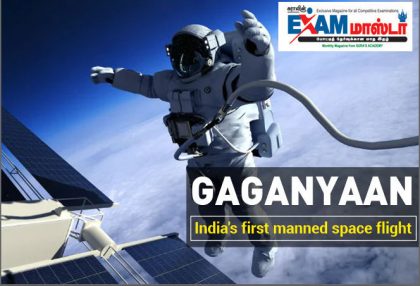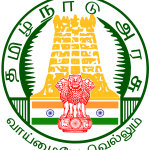
Introduction
On the occasion of India’s 72nd Independence Day on August 15, Prime Minister Narendra Modi announced that by the year 2022, an Indian astronaut, be it a man or a woman, will go on a space odyssey, on board ‘Gaganyaan’. While talking about this major step for the country, PM said that the manned space mission on board ‘Gaganyaan’ can take place when India will celebrate its 75th year of Independence in 2022 or, if possible, even earlier. He added that “an Indian son or daughter” will carry the national flag on this trip. It will be one of the major missions undertaken in India after the Chandrayaan-1 and Mars Orbiter Mission (MOM), also called Mangalyaan (September 2014).
What is Gaganyaan?
- Gaganyaan (The Sanskrit word ‘Gaganyaan’ means ‘Sky vehicle’) is an Indian space mission set to take place in or before 2022 where a man or a woman will be sent into the space on board the spacecraft known as the ‘Gaganyaan’. Following this mission, India will become the fourth nation in the world after United States, Russia and China to undertake a manned space mission.
- A human rated GSLV Mk-III will be used to carry the orbital module which will have necessary provisions for sustaining a 3-member crew for the desired duration of the mission. The necessary infrastructure for crew training, realization of flight systems and ground infrastructure will be established to support the Gaganyaan Programme. ISRO will collaborate extensively with national agencies, laboratories, academia and industry to accomplish the Gaganyaan Programme objectives.
- In its maiden crewed mission, Indian Space Research Organisation’s largely autonomous 3.7 tonne (8,200 lb) capsule will orbit the Earth at 400 km (250 mi) altitude for upto seven days with a two or three-person crew on board. The crewed vehicle is planned to be launched on ISRO’s GSLV Mk III in December 2021. The HAL- manufactured crew module has its first un-crewed experimental flight on 18 December 2014. As of May 2019, design of the crew module has been completed.
- ISRO’s Human Space Flight Centre and Glavcosmos, which is a subsidiary of the Russian state corporation Roscosmos, signed an agreement on July 1, 2019 for cooperation in the selection, support, medical examination and space training of Indian astronauts. An ISRO Technical Liaison Unit (ITLU) will be setup in Moscow to facilitate the development of some key technologies and establishment of special facilities which are essential to support life in space.
- Pad abort test : A Pad Abort Test is a trial run for the spacecraft’s launch abort system (sometimes called a launch escape system). This system is designed to quickly get the crew and spacecraft away from the rocket in the event of a potential failure. It is similar to an ejection seat for a fighter pilot, but instead of ejecting the pilot out of the spacecraft, the entire spacecraft is “ejected” away from the launch vehicle.
- The Indian Space Research Organisation’s Pad Abort Test was conducted successfully on 5 July 2018.
Expenditure
- The total fund requirement for the Gaganyaan Programme is approximately ` 10,000 crore and includes cost of technology development, flight hardware realization and essential infrastructure elements. Two unmanned flights and one manned flight will be undertaken as part of Gaganyaan Programme.
Implementation Strategy and Targets
- Gaganyaan Programme will be a national effort in collaboration with Industry, Academia and other scientific agencies and laboratories as stake holders along with ISRO. ISRO will be responsible for realizing the flight hardware through Industry. National agencies, laboratories and Academia will participate in crew training, human life science technology development initiatives as well as design reviews. First human space flight demonstration is targeted to be completed within 40 months from the date of sanction. Prior to this, two unmanned flights in full complement will be carried out to gain confidence on the technology and mission management aspects.
Impact
- The programme is expected to spur research and development within the country in niche science and technology domains.
- Huge potential for technology spinoffs in areas such as medicine, agriculture, industrial safety, pollution, waste management, water and food resource management etc.
- Human spaceflight programme will provide a unique micro-gravity platform in space for conducting experiments and test bed for future technologies.
- The programme is expected to give impetus to economic activities within the country in terms of employment generation, human resource development and enhanced industrial capabilities.
- Human Spaceflight capability will enable India to participate as a collaborating partner in future Global space exploration initiatives with long term national benefits.
Journey so far
- ISRO has completed the development of launch vehicle GSLV Mk-III which has the necessary payload capability to launch a 3-member crew module in low earth orbit. ISRO has also tested the crew escape system which is an essential technology for human space flight. The aerodynamic characterization of crew module has been completed as part of GSLV Mk-III X mission flight. Elements of life support system and Space suit also have been realized and tested. In addition, the orbital & re-entry mission and recovery operations have been flight demonstrated in Space Capsule Re-entry experiment (SRE) mission. ISRO has developed and demonstrated most of the baseline technologies essential for undertaking human spaceflight mission. Globally also, there is a renewed interest in undertaking manned exploration initiatives.
NOTES:
- Yuri Gagarin a soviet Air Force pilot was the first human to orbit around the Earth on April 12, 1961 in the space capsule Vostok 1
- Rakesh Sharma, an Indian air force pilot was the First Indian to journey into space. He flew aboard in a Soyuz-T11 spacecraft on April 2, 1984.
Some important facts about India’s ambitious mission – Gaganyaan
- The crew module, in which the three astronauts will leave for space, will be made of 3.7 metre diameter and seven-metre height.
- According to G. Madhavan Nair, former ISRO chief : The mission will enable ISRO to achieve higher levels of reliability in launch and satellite technology. It will help in providing employment to 15,000 people and out of them, 861 will be from ISRO.
- The human spaceflight will take 16 minutes to reach the orbit where it will stay for five to seven days.
- The spacecraft will be placed in a low earth orbit of 300-400 km.
- The Indian space agency displayed the Gaganyaan crew model and orange space suits at the Bengaluru Space Expo’s 6th edition earlier this year. The space suit were developed at Vikram Sarabhai Space Centre, Thiruvananthapuram.
- With the ability to hold one oxygen cylinder, the suit will allow the astronaut to breathe in space for 60 minutes.
- The capsule will rotate around the Earth every 90 minutes, and astronauts will be able to witness sunrise and sunset. The three astronauts will be able to see India from space every 24 hours, while they conduct experiments on micro-gravity.
- For its return, the capsule will take 36 hours, and will land in the Arabian Sea, just off the coast of Gujarat.
- ISRO will receive assistance from the French Space Agency CNES, in terms of expertise in various fields including space medicine, astronaut health monitoring, radiation protection and life support.




